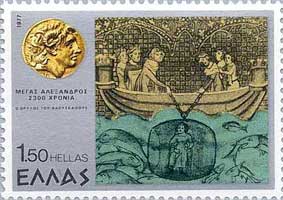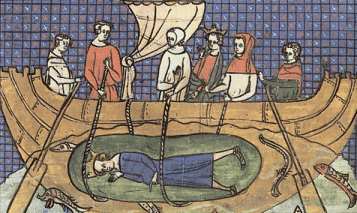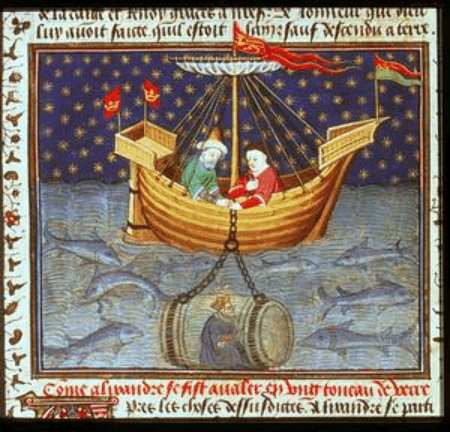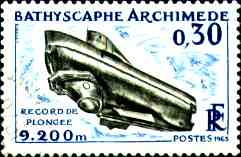.
Bathysphere. This reinforced spherical deep-sea chamber in which people are lowered by a cable to study the ocean and marine life was invented and named by American scientist and author William Beebee in 1930. Dr. Beebee later described the coinage exactly: "As the great chamber took shape, we found the need of a definite name. We spoke of it casually and quite incorrectly as tank and cylinder and bell. One day, when I was writing the name of a deep-sea fish—Bathytroctes— the appropriateness of the Greek prefix occurred to me; I coined the word Bathysphere, and the name has stuck." The Greek prefix bathy is so appropriate because it means "deep"; sphere, also from the Greek, is self-explanatory. : Source

Alexander the Great visits the bottom of the sea in a kind of diving-bell. The fish crowd round him and pay homage. Image from the 'Romance of Alexander', a manuscript written and illustrated in Flanders (1340?) The device was called Colimpha.
See a version from the Oxford University Bodleian Library http://image.ox.ac.uk/show?collection=bodleian&manuscript=msbodl264 Image (5 MB)
Was the bathysphere used much earlier by Alexander the Great? The beginnings of the diving bell are primitive but functional devices, containers such as buckets or cauldrons. These devices trapped air when inverted and were placed over the diver's head before he entered the water. The first references to underwater activity dates from Egyptian Antiquity at the Thebes temples.
At 500 BC Scyllias, a sculptor, and his daughter Cyana were Greek divers who worked recovering treasure for the Persian king Xerxes, breath holding. Xerxes wouldn’t let them return to their country, and so seizing an opportunity they found his fleet in difficulty, cut the anchors underwater and caused a great catastrophe. Cyana was the first working woman diver. Divers worked at bringing back cargoes from sunken ships. Holding their breath, they could stay underwater for around two minutes.
As Herodotus writes:
Now the Persians had with them a man named Scyllias, a native of Scione, who was the most expert diver of his day. At the time of the shipwreck off Mount Pelion he had recovered for the Persians a great part of what they lost; and at the same time he had taken care to obtain for himself a good share of the treasure. He had for some time been wishing to go over to the Greeks; but no good opportunity had offered till now, when the Persians were making the muster of their ships. In what way he contrived to reach the Greeks I am not able to say for certain: I marvel much if the tale that is commonly told be true. 'Tis said he dived into the sea at Aphetae, and did not once come to the surface till he reached Artemisium, a distance of nearly eighty furlongs (15 kilometers). Now many things are related of this man which are plainly false; but some of the stories seem to be true. My own opinion is that on this occasion he made the passage to Artemisium in a boat. However this might be, Scyllias no sooner reached Artemisium than he gave the Greek captains a full account of the damage done by the storm, and likewise told them of the ships sent to make the circuit of Euboea.
Scyllias was given riches and Cyana was rewarded with a white horse.
The history of sponge divers is more than 2300 years old. Aristotle mentions that the quality of the sponges improves the deeper a sponge grows.
Aristotle, in “Problemata”, tells the tale of Alexander the Great. At the siege of Tyre, in 332 BC, he ordered divers to destroy any submarine defenses the city might undertake to build. While in none of these records does it actually say he had any kind of submersible vehicle, legend has it that he descended in a device which kept its occupants dry and admitted light. He was lowered in a diving bell, also noted in the Roman 12th century Alexandria which, in iambic lines of six feet or twelve syllables of verse (hence the term Alexandrine) relates the tale that Alexander had built "a very fine barrel made entirely of white glass" which was towed out to sea and lowered into the water. In the Alexandria version, two companions accompanied Alexander and all were stunned by what they saw by the bright lights emanating from the diving machine. Alexander is quoted as observing, from what he had seen underwater, that "...the world is damned and lost. The large and powerful fish devour the small fry." Another story regarding Alexander's underwater adventures was published in 1886 in France. At the age of 11, Alexander entered a glass case, reinforced by metal bands and had himself lowered into the sea by a chain over 600 feet long.

Aristotle wrote, "...they enable the divers to respire equally well by letting down a cauldron, for this does not fill with water, but retains the air, for it is forced straight down into the water." Other observers have remarked that the heating of the air, by breathing and by pressure, posed a problem for bell divers. Aristotle says that a breathing tube is used by divers: Just as divers are sometimes provided with instruments for respiration, through which they can draw air from above the water, and thus may remain a long time under the sea, so also have elephants been furnished by nature with their lengthened nostril; and, whenever they have to traverse water, they lift this up above the surface and breathe through it, Parts of Animals.

In 1250 Roger Bacon, in ”De Mirabili”, speaks of devices which can be "made by means of which men could walk on the bed of the ocean without harm to their bodies. Alexander used such a device in order to discover the secrets of the sea. Some say that the material such as the metallic chain that was used as shown in the stamp of Alexander the Great were never so stable to be used without breaking. There is some evidence that a primitive sub was built around 200 B.C. in China.

How Alexander lowered himself into the Sea in a Glass Barrel. Miniature , 13th century No. 11040, Burgundy Library Brussels

The Bathyscaphe Archimedes from France reaching 9200 meters.
The first successful submersible vessel was probably build around 1620 by the Dutch Cornelius Van Drebbel. A wooden watertight boat carried 12 rowers and a total of 20 men. This vessel made successful divings in the Thames River in a depth of 20 meters.
References
Arthur J. Bachrach, The History of the Diving Bell
Submarines: The story of underwater craft from the diving bell of 300 B.C. to nuclear-powered ships (The Golden library of knowledge)
| Ancient Greece
Science, Technology , Medicine , Warfare, , Biographies , Life , Cities/Places/Maps , Arts , Literature , Philosophy ,Olympics, Mythology , History , Images Medieval Greece / Byzantine Empire Science, Technology, Arts, , Warfare , Literature, Biographies, Icons, History Modern Greece Cities, Islands, Regions, Fauna/Flora ,Biographies , History , Warfare, Science/Technology, Literature, Music , Arts , Film/Actors , Sport , Fashion --- |

